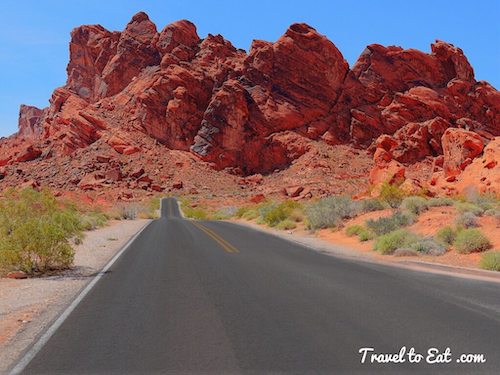
The weather has been nice out here in Las Vegas, so I thought I would do a day trip to the Valley of Fire to check out the scenery and spring flowers. The Valley of Fire derives its name from red sandstone formations, formed from great shifting sand dunes during the age of dinosaurs, 150 million years ago. Complex uplifting and faulting of the region, followed by extensive erosion, have created the present landscape. Other important rock formations include limestones, shales, and conglomerates. Prehistoric users of the Valley of Fire included the Basket Maker people and later the Anasazi Pueblo farmers from the nearby fertile Moapa Valley. The span of approximate occupation has been dated from 300 BCE to 1150 CE. Their visits probably involved hunting, food gathering, and religious ceremonies, although scarcity of water would have limited the length of their stay. Fine examples of rock art left by these ancient peoples can be found at several sites within the park.













Many rock faces are covered with desert varnish, a naturally occurring dark patina that forms on the surface of rocks in the desert. Native peoples who lived in the area created petroglyphs by pecking away the desert varnish to reveal the underlying light-colored sandstone rock. Although petroglyphs are present throughout the entire park, Mouse's Tank and Atlatl Rock are two areas in particular which have many petroglyphs while being relatively easily accessible. Hand-thrown spears have limited speed, range, and accuracy. Sometime before 17,000 years ago, humans invented a launching tool that greatly improved the effectiveness of spears. In North America the launching tools are known by their Aztec name, “atlatl.” Eric Parrish's drawing shows how an atlatl works to extend a thrower's arm. Eventually a new invention, the bow and arrow, replaced atlatl, but not completely. The Spanish who conquered Mexico encountered atlatl-using warriors. The Basketmaker style of Atlatl is named after the cultures of the American southwest. This design is unique to the Americas, and it is the one most found in the archaeological record, throughout rock art and in dry caves. One of the earliest known examples is a 17,500 year-old Solutrean atlatl made of reindeer antler and found at Combe Saunière (Dordogne), France.




The park also features three cabins built by the Civilian Conservation Corps, which were once used by overnight campers (now prohibited). Now a picnic area, these historic cabins were built with Valley of Fire sandstone by the Civilian Conservation Corps (CCC) in the 1930s for travelers. They are now being preserved as a reminder of the work done by Thomas W Miller, the first state Park Commission Chairman. Almost 9,000 people visited the newly opened park in 1936. Today over 200,000 visitors enjoy the Valley of Fire every year.






Seven Sisters at Valley of Fire State Park is a group of seven tall, red, eroded boulders surround by the sandy desert. Once part of the nearby red formations, these rock towers are all that remain after the relentless forces of erosion stripped away the surrounding sandstone deposits. Numerous “blow holes” forecast the eventual destruction of the towers that will take place many hundreds of years in the future. The Valley of Fire is a celebrated photographic location and these photos are a first attempt to capture the beauty to be found here. I will try again in the future but if you come to Las Vegas, you should visit.
[mappress mapid=”20″]
References:
Valley of Fire State Park: http://parks.nv.gov/parks/valley-of-fire-state-park/
Atlatl Replicas: http://www.atlatl.com/authentic-atlatls.php
Spear Thrower: http://www.kbinirsnb.be/europancestors//en/mv/culture/propulseur/body
Musée d'Archéologie Nationale: http://www.musee-archeologienationale.fr/
Valley of Fire Photographs: http://www.lovethesepics.com/2014/03/incredible-rocky-rainbow-vista-carved-into-the-valley-of-fire-38-pics/

